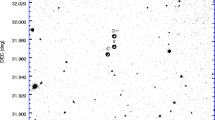Abstract
Photometric observations of the symbiotic star EG and confirm that the binary system is eclipsing. The epoch of primary minimum is computed. The new period 474 days instead of 470 days is estimated by a comparison of line profiles of Balmer lines taken in 1967–69 and 1982–84. The new ephemeris is
Similar content being viewed by others
References
Kaler, J. B., Hickey, J. P.: 1983, Publ. Astron. Soc. Pacific95, 759.
Kenyon, S. J.: 1983, PhD thesis, University of Illinois
Oliversen, N. A., Anderson, C. M., Stencel, R. E., Slovak, M. H.: 1985, Astrophys. J.295, 620.
Smith, S. E.: 1980, Astrophys. J.237, 831.
Stencel, R. E.: 1982, “Advances in Ultraviolet Astronomy: Four Years of IUE Research”, NASA Conference Publication 2238, p. 219.
Stencel, R. E.: 1983, Bull. Am. Astron. Soc.15, 927.
Author information
Authors and Affiliations
Rights and permissions
About this article
Cite this article
Chochol, D., Skopal, A., Vittone, A. et al. The symbiotic binary system EG Andromedae. Astrophys Space Sci 131, 755–758 (1987). https://doi.org/10.1007/BF00668168
Issue Date:
DOI: https://doi.org/10.1007/BF00668168



